Its been a while since I got my DF64 grinder.
I had my fair bit of trouble, like the motor not spinning which I did manage to fix, but I have been enjoying the grinder ever since.
There was a mod which I did right after getting the grinder so I would like to share this with you today.
If you are feeling that your coffee is not consistent even though you are using the same bean to water ratio, this mod might be able to help you.
I will be showing you how to do this with my DF64, but the idea would be the same for most grinders.
What is retention?
I just want to quickly explain what retention is.
As the word implies, retention is the amount of coffee beans which your grinder retains and holds onto with in the gaps and corners in side the grinder itself.
Simply put, it is the difference between the weight of beans you put in, and the weight of ground coffee you get out from your grinder.
If you are single dosing, this is very easy to measure. Just weigh your beans before and after grinding.
If the weight matches, you generally have low retention.
I say generally because you could have high retention and exchange, but lets keep things simple.
When you have high retention, there are mainly three issues.
First, it will throw off recipe consistency.
Even if you carefully weight out your beans before grinding, if your grinder retains a lot of your grounds, you might not have the ratio you were aiming for in the cup.
When your grinder retains grounds, you usually get less out than you put in. But these retained grounds obviously don’t disappear. So occasionally, a bunch of the accumulated grounds come out, which will give you more than you put in.
Weighing your dose after you grind is a way around this issue, but thats wasteful and frankly annoying to do.
Second, make purging necessary between grind adjustments.
When you are dialing in your grind size, high retention is a big issue. This is because when you adjust your settings, the retained grounds are ground at your previous setting. The retained grounds will get pushed out first, which means you will get a mix of your old and new setting.
This forces you to need a purge, which is to run some beans through after an adjustment, and throwing it out. Wasteful, no good.
A low retention grinder will not be affected by this, so it will make life a lot easier, especially if you are like me and constantly switch between espresso and filter.
Third, the retained coffee stales.
We all know that grinding fresh is the key to great coffee. That why we got a grinder in the first place.
High retention means that those retained grounds are pre-ground coffee sitting in your grinder. This kind of defeats the purpose of grinding fresh.
So for these reasons you want to have as low retention as possible in your grinder.
How is the DF64 retention?
The amount of retention depends greatly on the design of the grinder.
I measured the dose in and out from the DF64, as it came from the factory.
The DF64 comes with a bellows to blow out the retained grinds, so I also measured how much that helps.
Here are the results. The retention is based off of the post-bellow dose.
(Note a positive retention means, less grounds out than in.)
| Grind setting | Dose In (g) | Dose Out (g) Pre-Bellow | Dose Out (g) Post-Bellow | Retention (g) |
|---|---|---|---|---|
| 65 | 18.0 | 17.1 | 17.2 | 0.8 |
| 65 | 18.0 | 17.8 | 17.8 | 0.2 |
| 65 | 18.0 | 17.7 | 17.8 | 0.2 |
| 65 | 18.0 | 15.8 | 15.8 | 2.2 |
| 65 | 18.0 | 17.8 | 17.8 | 0.2 |
| 65 | 18.0 | 18.2 | 18.2 | -0.2 |
| 65 | 18.0 | 18.0 | 18.0 | 0.0 |
| 65 | 9.0 | 11.0 | 11.0 | -2.0 |
| 65 | 9.2 | 9.0 | 9.2 | 0.0 |
| 65 | 9.1 | 9.0 | 9.2 | -0.1 |
| 27 | 12.1 | 10.5 | 10.5 | 1.6 |
| 60 | 9.0 | 9.2 | 9.4 | -0.4 |
| 60 | 9.1 | 9.0 | 9.2 | -0.1 |
| 35 | 12.2 | 11.3 | 11.7 | 0.5 |
| 70 | 9.0 | 8.9 | 9.1 | -0.1 |
| 80 | 10.1 | 9.9 | 10.1 | 0.0 |
| 25 | 10.0 | 9.7 | 9.9 | 0.1 |
| 25 | 9.9 | 9.4 | 9.6 | 0.3 |
| 25 | 12.0 | 11.3 | 11.6 | 0.4 |
Just to make it a bit easier to see, heres a graph representation of the retention.

From the results, the retention performance of the D64 is quite disappointing…
Some times you loose 2g, some time you get 2g. It’s kind of all over the place.
I usually use 9g of coffee for a single cup filter coffee, if there is a 2g deviation thats a 20% change in my dose. There is no way I can get consistent cups.
I actually was able to visibly see that there was less / more grounds.
The DF64 does say No retention on their website, but that’s a bit of an over statement, in my opinion.
The general consensus seems to be that no or low retention is about less than 0.3g.
So was I doomed? Did I get a bad grinder?
Well actually, and thankfully, no.
The DF64 is kind of known for its bad retention out of the box.
Where is the retention happening? How can we fix it?
Let’s look inside the grinder to check where the issue is.
First let’s look in the grind chamber.
Unplug the power, then unscrew the silver zero indicator ring, and keep going coarse on the adjustment dial to pop it off

The inside looks like this.

At first glance, I don’t see too much retention…
But wait…? What?
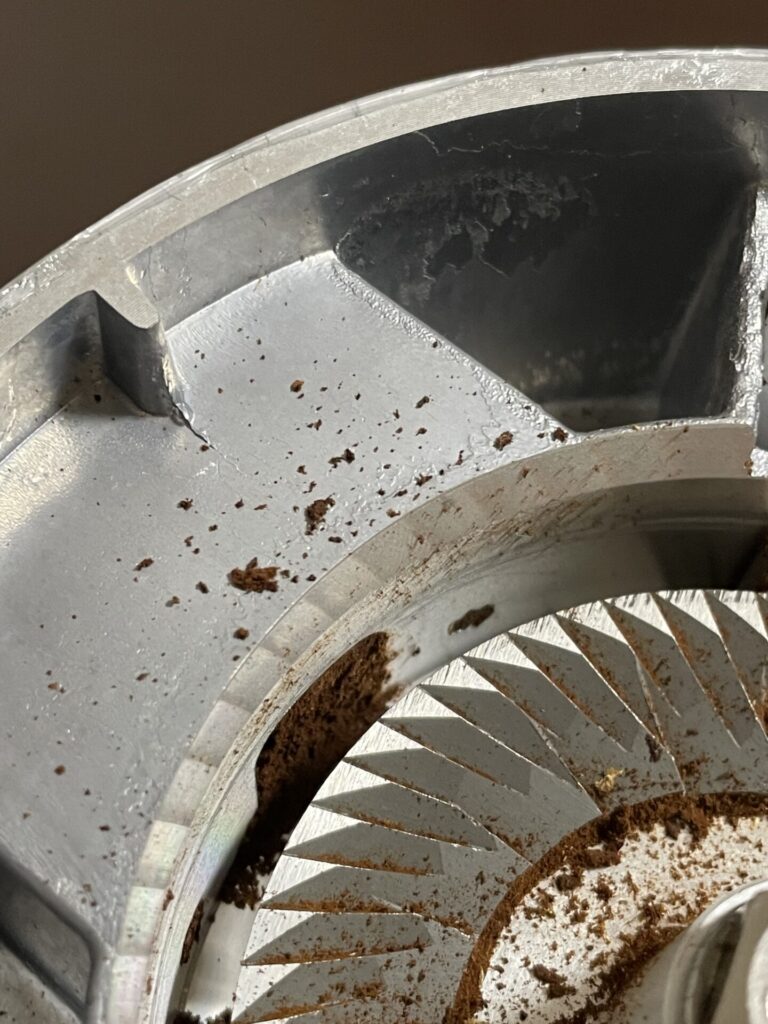
The exit hole out of the grinder is jam packed with grinds?! How does that even happen?
Ok, we need to take a look at the exit chute.
To do this, we need to flip the grinder over and remove this bold on the portafilter fork.
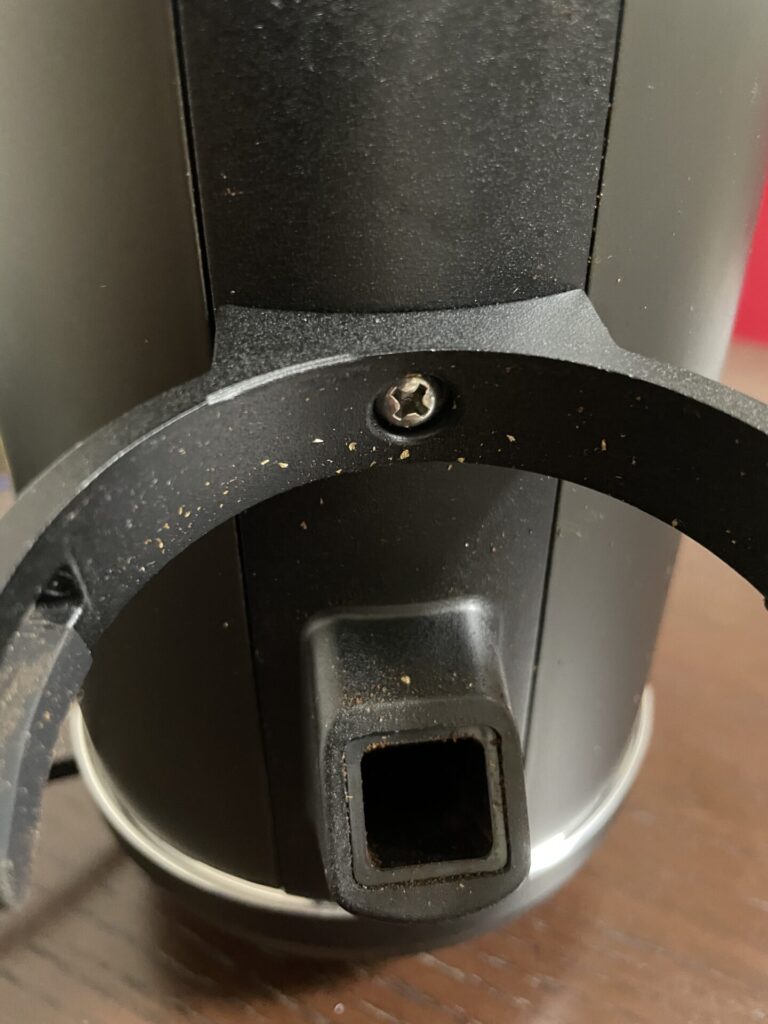
There is another pair of bolts behind the fork, so remove those.

Unscrew the bolts on the bottom of the grinder to detach the base.
The inside looks like this.

If we unscrew the nut holding the blue switch, we can pop it out together with the front panel part.
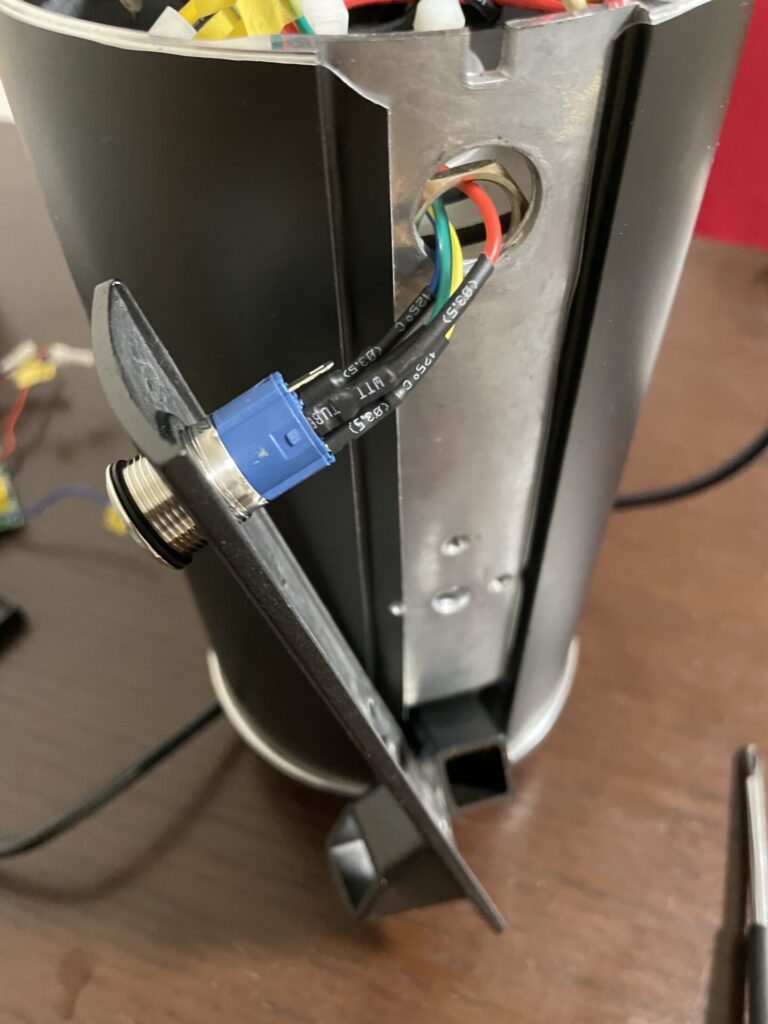
There are some more bolts holding the exit chute, so remove those.
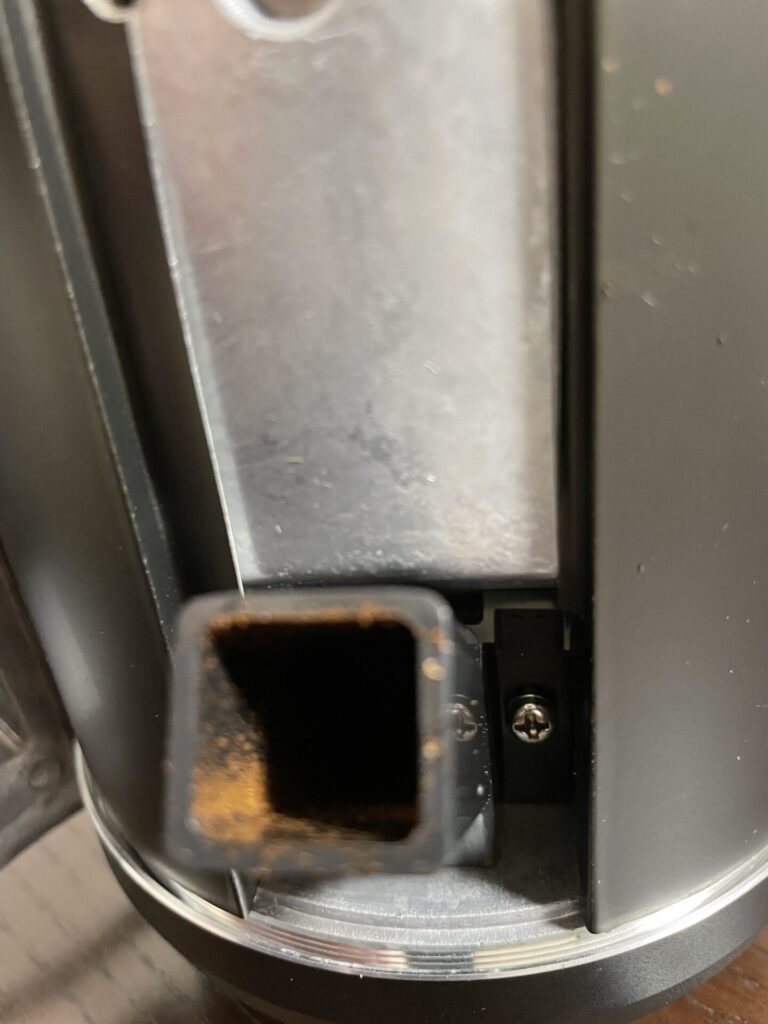
Off comes the plastic exit chute.
And WOW! thats a lot of grounds.
The clear plastic sheets are call the declumper.
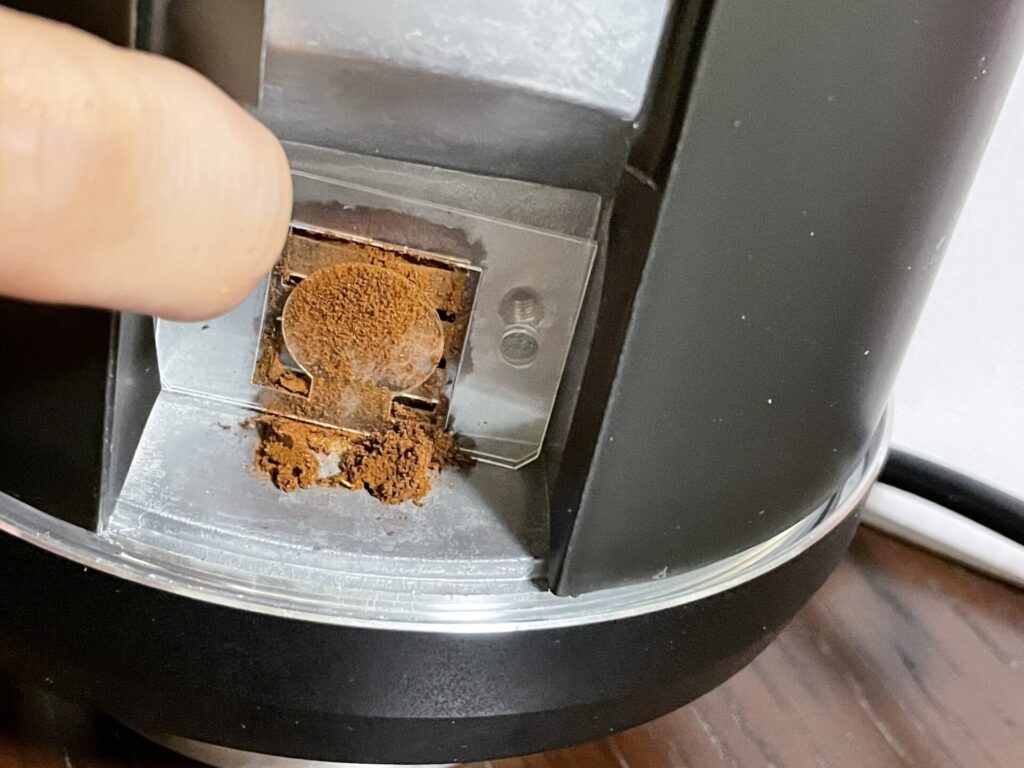
Again WOW. It is packed…
I don’t even know how any grinds came out.

So clearly the issue is with these declumpers.
The purpose of these plastic sheets are, to break up the clumps of grounds produced when the burrs grind the beans. They also act to prevent the ground making a mess when they come out of the chute.
There are actually 2 declumper sheets installed on the DF64. By the way, my machine seems to be called the version 4 of the DF64.
As far as I was able to find out, this was one of the improvements (?) made on version 4.
They are made of pretty stiff plastic sheets.

This is how they are installed from the side. The round one is on the outside.
I can hardly push it out with my finger. No wonder there was so much retention.

Declumper Mod : Try using just one sheet
OK, lets make some modifications and try to improve the retention.
I first tried just using one of the sheets. I used the one on the right.

The mod is very easy, but one place to watch out for are these bolts holding the exit chute.
The holes they screw into go all the way through to the grind chamber side.
So if you tighten these screws too much, the heads will stick out on the other side preventing the burr from rotating, and possibly even damaging the grinder.

You could just tighten it less, but I was afraid that vibrations might dislocate them. So I got some M4 nuts and used them as a spacer (the left bolt in picture).
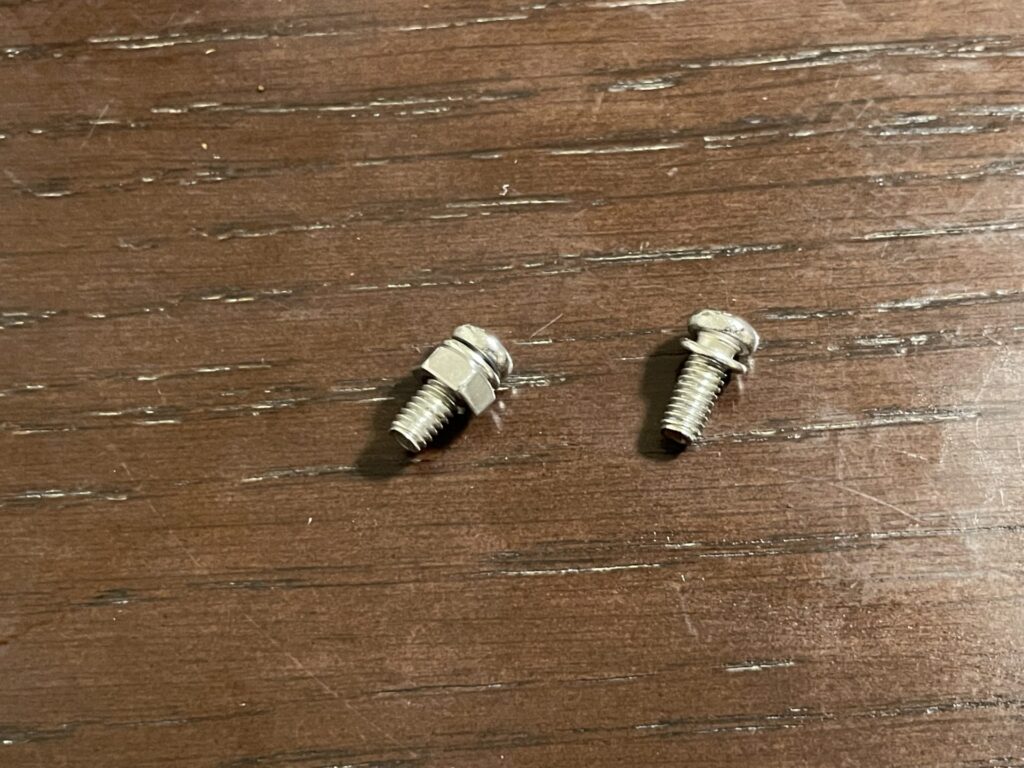
So how were the results after the mod?
| Grind setting | Dose In (g) | Dose Out (g) Pre-Bellow | Dose Out (g) Post-Bellow | Retention (g) |
|---|---|---|---|---|
| 25 | 10.1 | 9.8 | 10.0 | 0.1 |
| 25 | 10.0 | 9.8 | 10.0 | 0.0 |
| 25 | 10.1 | 9.6 | 10.0 | 0.1 |
| 60 | 10.0 | 9.6 | 10.1 | -0.1 |
| 60 | 10.0 | 9.4 | 9.9 | 0.1 |
| 60 | 10.0 | 9.5 | 10.0 | 0.0 |
| 25 | 10.0 | 9.4 | 9.8 | 0.2 |
| 25 | 10.1 | 9.8 | 10.1 | 0.0 |
| 60 | 10.0 | 9.5 | 10.0 | 0.0 |
| 60 | 10.0 | 9.5 | 9.9 | 0.1 |
| 55 | 9.0 | 8.4 | 8.8 | 0.2 |
| 20 | 12.2 | 11.4 | 11.8 | 0.4 |
| 50 | 9.1 | 8.9 | 9.4 | -0.3 |
| 50 | 9.2 | 8.6 | 9.1 | 0.1 |
| 15 | 12.1 | 11.4 | 11.6 | 0.5 |
| 50 | 9.2 | 9.3 | 9.5 | -0.3 |
| 13 | 12.2 | 10.8 | 11.5 | 0.7 |
| 12 | 12.2 | 10.5 | 11.5 | 0.7 |
| 40 | 9.0 | 9.1 | 9.6 | -0.6 |
| 12 | 12.2 | 9.8 | 11.3 | 0.9 |
| 12 | 12.1 | 10.3 | 12.1 | 0.0 |
| 50 | 9.0 | 9.5 | 9.8 | -0.8 |
| 13 | 11.9 | 11.2 | 11.5 | 0.4 |
| 52 | 9.0 | 9.2 | 9.5 | -0.5 |
| 11 | 11.9 | 9.5 | 11.3 | 0.6 |
| 60 | 20.2 | 20.5 | 20.8 | -0.6 |
| 60 | 10.0 | 9.6 | 10.0 | 0.0 |
| 11 | 12.1 | 11.0 | 11.3 | 0.8 |
| 70 | 9.0 | 9.3 | 9.7 | -0.7 |

Quite a bit better, but still about 1g.
Thats about half of what it use to be.
Let’s look inside again.
As you can see there’s still a bit left at the chute. But that seems much better than the original.
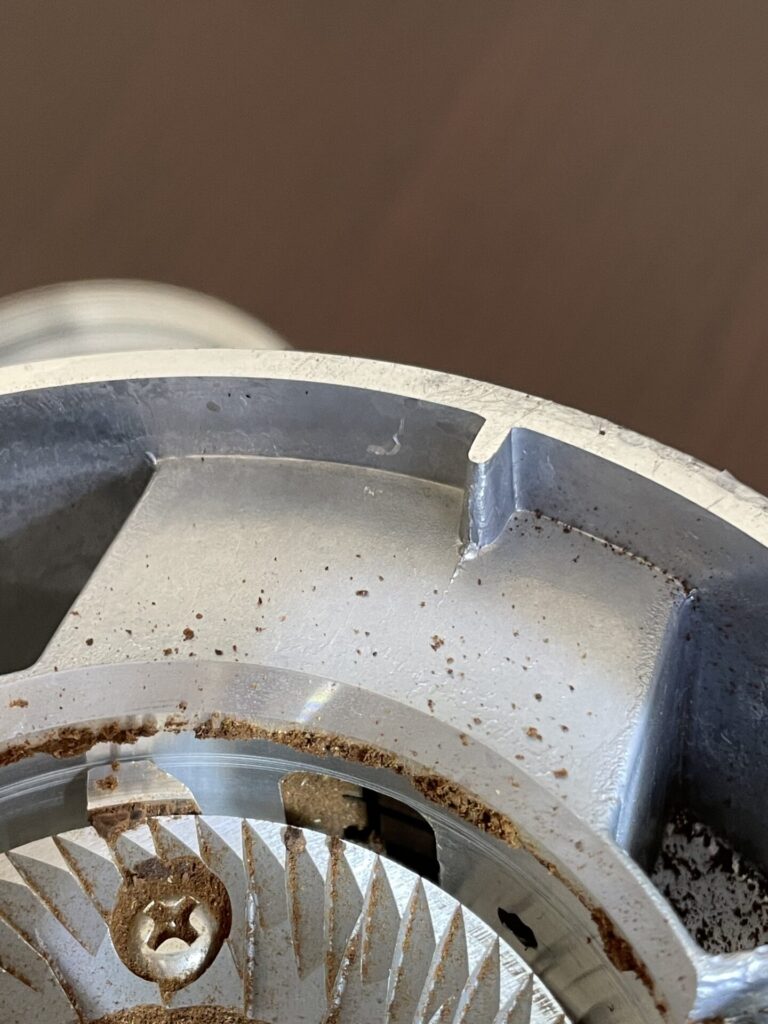
I was wondering where the rest of the ground were, until I checked the chute.
And I don’t know why its stuck there but.. well here it was.
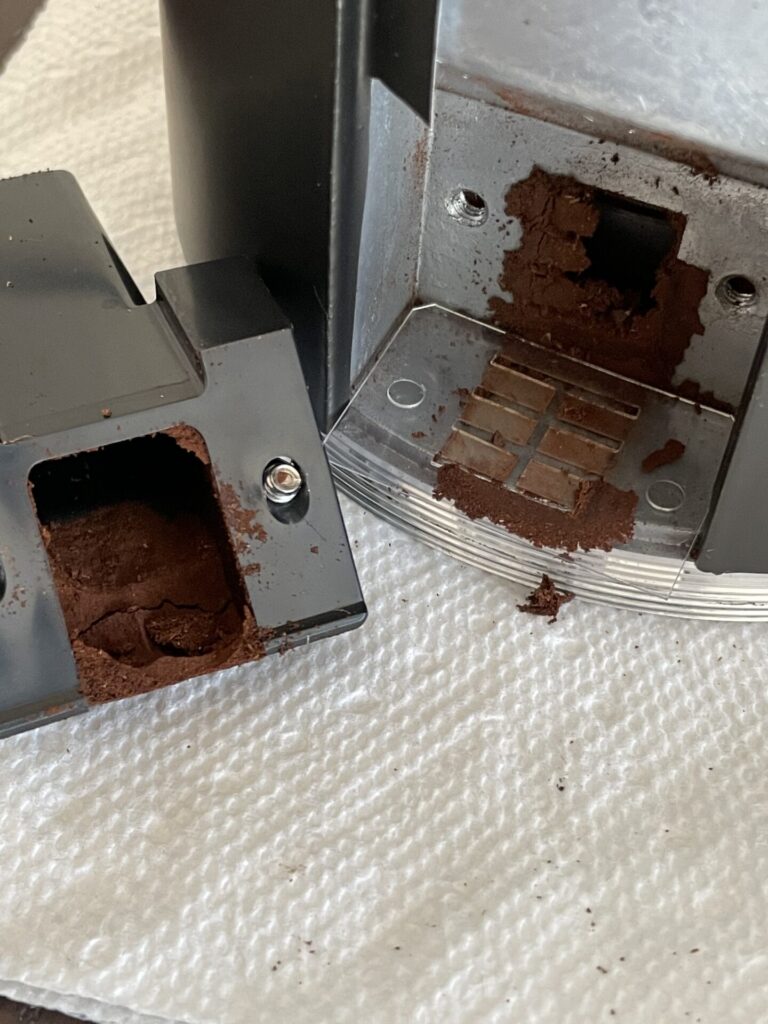
Thats a lot of retained grounds…
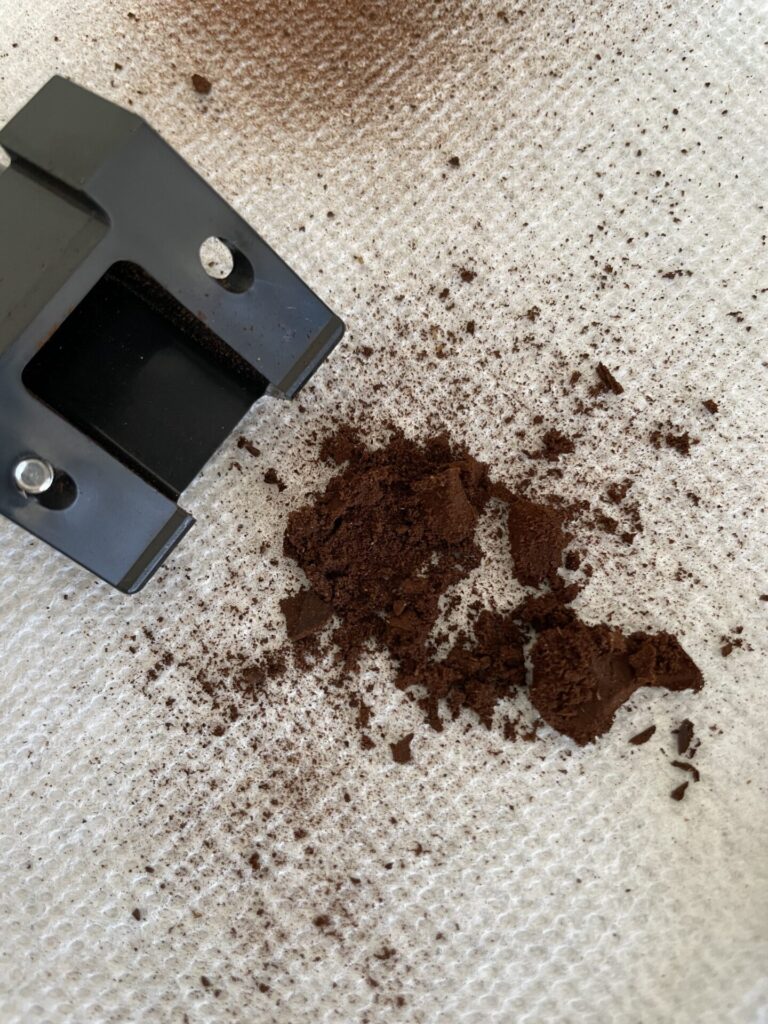
Further mod:No Declumper
So next I just removed all the declumper sheets.
But I noticed that the chute part has these notches at the top, which prevent the part from becoming flush with the body of the grinder. This is a potential area where grounds can get stuck.
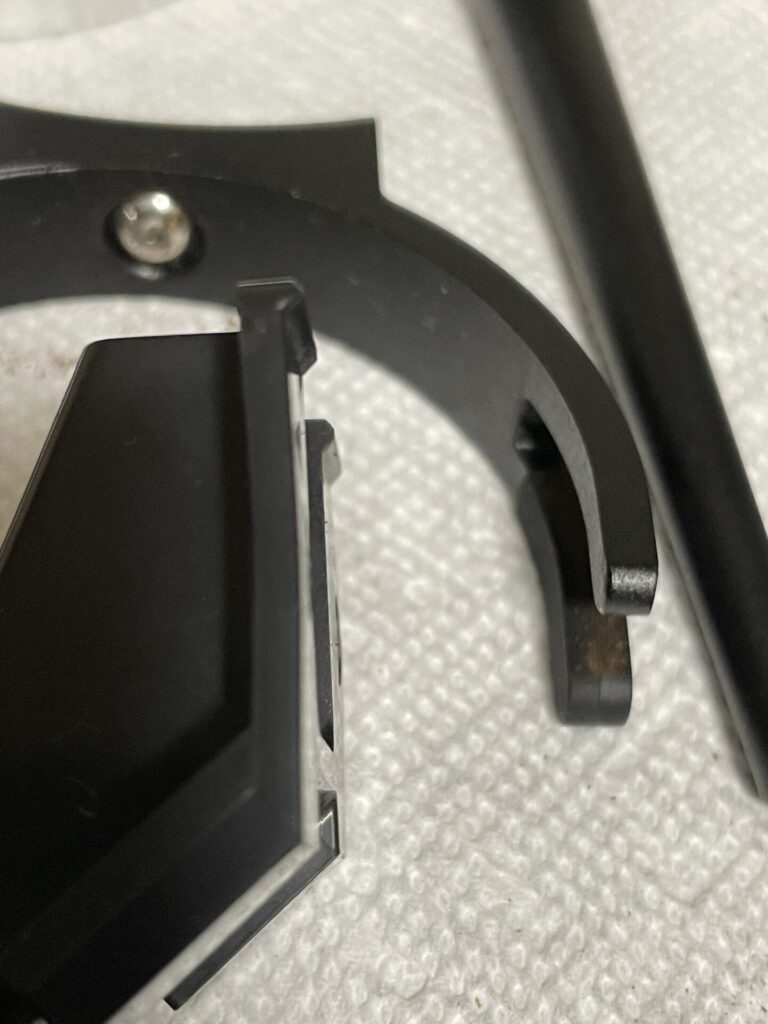
So I used the spare white silicone declumper.
I understand that this was the declumper used in version 1 of the DF64.
It’s awesome that the manufacture is listening to the feedback from the customers and upgrading their designs, and also that they still give you the parts from the previous versions if you want to go back to them.

Of course I don’t want to add this back in as is, so I took a knife and cut out the flaps.
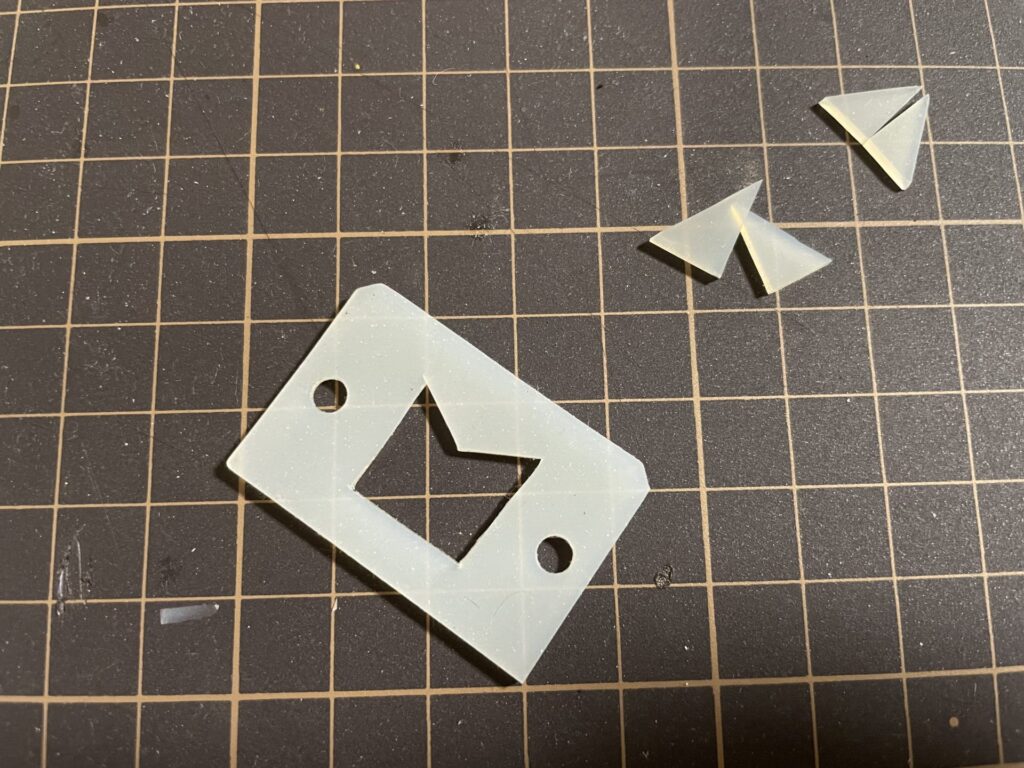
And placed it in like so, this will nicely fill the gap. I left the top flap in an attempt to prevent the build up at the top of the chute.

And my final results are as follows
| Grind setting | Dose In (g) | Dose Out (g) Pre-Bellow | Dose Out (g) Post-Bellow | Retention (g) |
|---|---|---|---|---|
| 29 | 9.2 | 8.8 | 8.9 | 0.3 |
| 60 | 9.0 | 9.3 | 9.3 | -0.3 |
| 60 | 9.9 | 9.9 | 10.0 | -0.1 |
| 60 | 10.0 | 10.0 | 10.0 | 0.0 |
| 60 | 10.0 | 9.9 | 10.0 | 0.0 |
| 60 | 10.0 | 10.1 | 10.1 | -0.1 |
| 25 | 10.2 | 9.9 | 10.2 | 0.0 |
| 25 | 10.0 | 9.9 | 9.9 | 0.1 |
| 25 | 10.2 | 9.9 | 10.1 | 0.1 |
| 25 | 10.1 | 9.9 | 9.9 | 0.2 |
| 25 | 10.2 | 10.0 | 10.1 | 0.1 |
| 60 | 10.0 | 10.0 | 10.0 | 0.0 |
| 25 | 10.0 | 9.9 | 10.0 | 0.0 |
| 60 | 10.0 | 9.8 | 9.9 | 0.1 |
| 15 | 12.1 | 11.6 | 12.0 | 0.1 |
| 50 | 9.1 | 9.2 | 9.2 | -0.1 |
| 11 | 12.1 | 11.3 | 11.7 | 0.4 |
| 45 | 9.2 | 9.5 | 9.5 | -0.3 |
| 45 | 30.0 | 29.9 | 30.0 | 0.0 |
| 42 | 9.0 | 9.2 | 9.1 | -0.1 |
| 43 | 8.9 | 9.0 | 9.0 | -0.1 |

Pretty awesome!
The mod was able to get the retention down within about 0.4g. That should be good enough.
Let me just put all the graphs side by side, so as to compare the results

That’s some clear improvement! I’m quite satisfied.
Why isn’t it like this from the factory?
This is probably what most are thinking.
I am very sure that the manufacture has done a lot more testing than I have.
But when why did they choose to go with the original configuration?
My guess is that they prioritized the cleanness of the grinder over the retention performance.
After removing all the declumpers, the DF64 shoots out the grinds all over the place because of static.
I suppose the manufacturers wanted to tackle this obviously visible issue more.
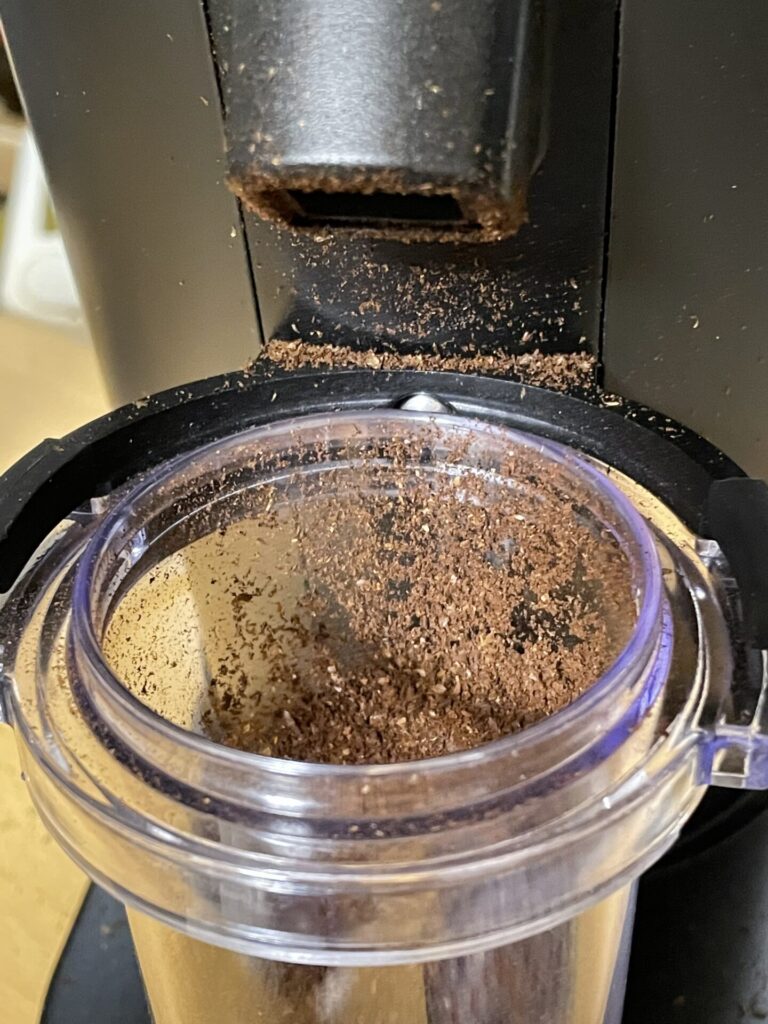
But there is a trick to mitigate this mess. I wrote about this in this post as well, but it’s called the RDT (Ross Droplet Technique).
Just spray a bit of water on the beans before grinding. That’s it.
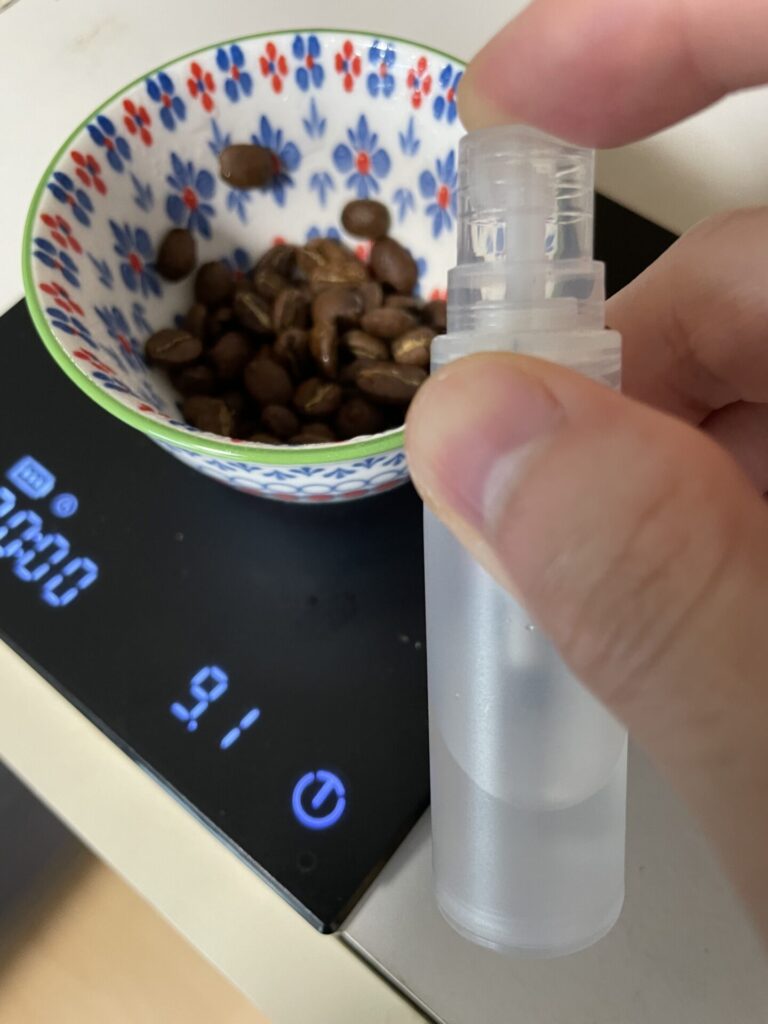
This simple trick will drastically improve the mess.
It is one more thing you have to do, but I would take the low retention any day.
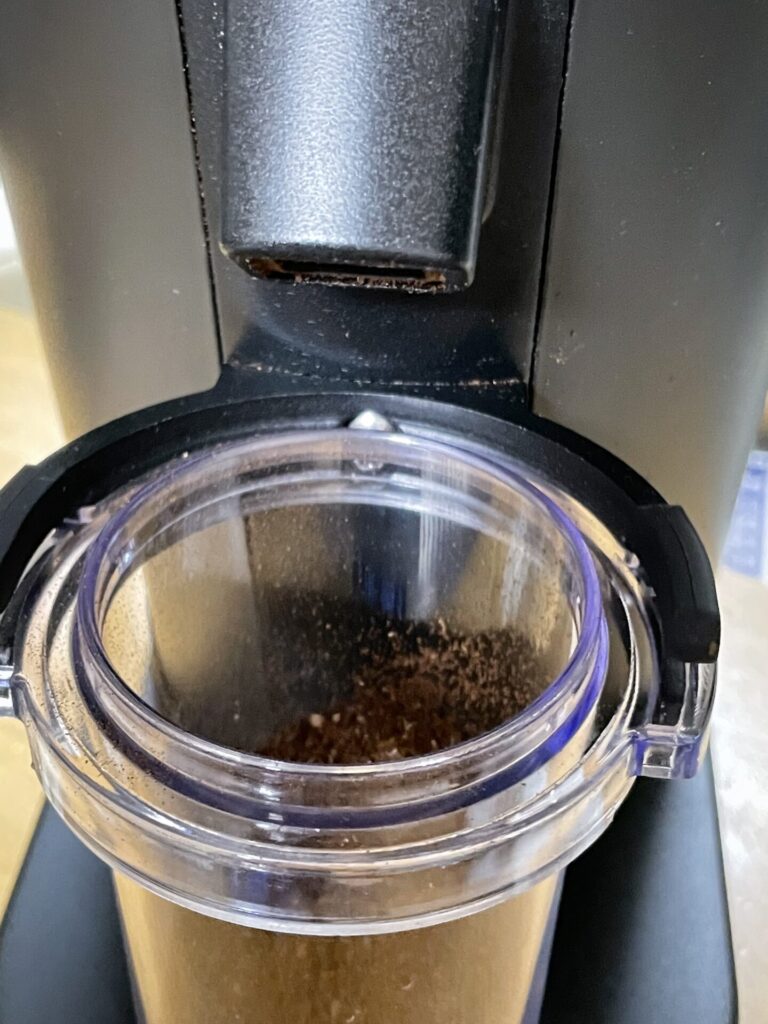
Thank you so much for sticking with me to the end!
The principles of what I did will apply to most grinders, so if you are having trouble with consistency it might be worth while to look inside your grinder to see what’s going on.


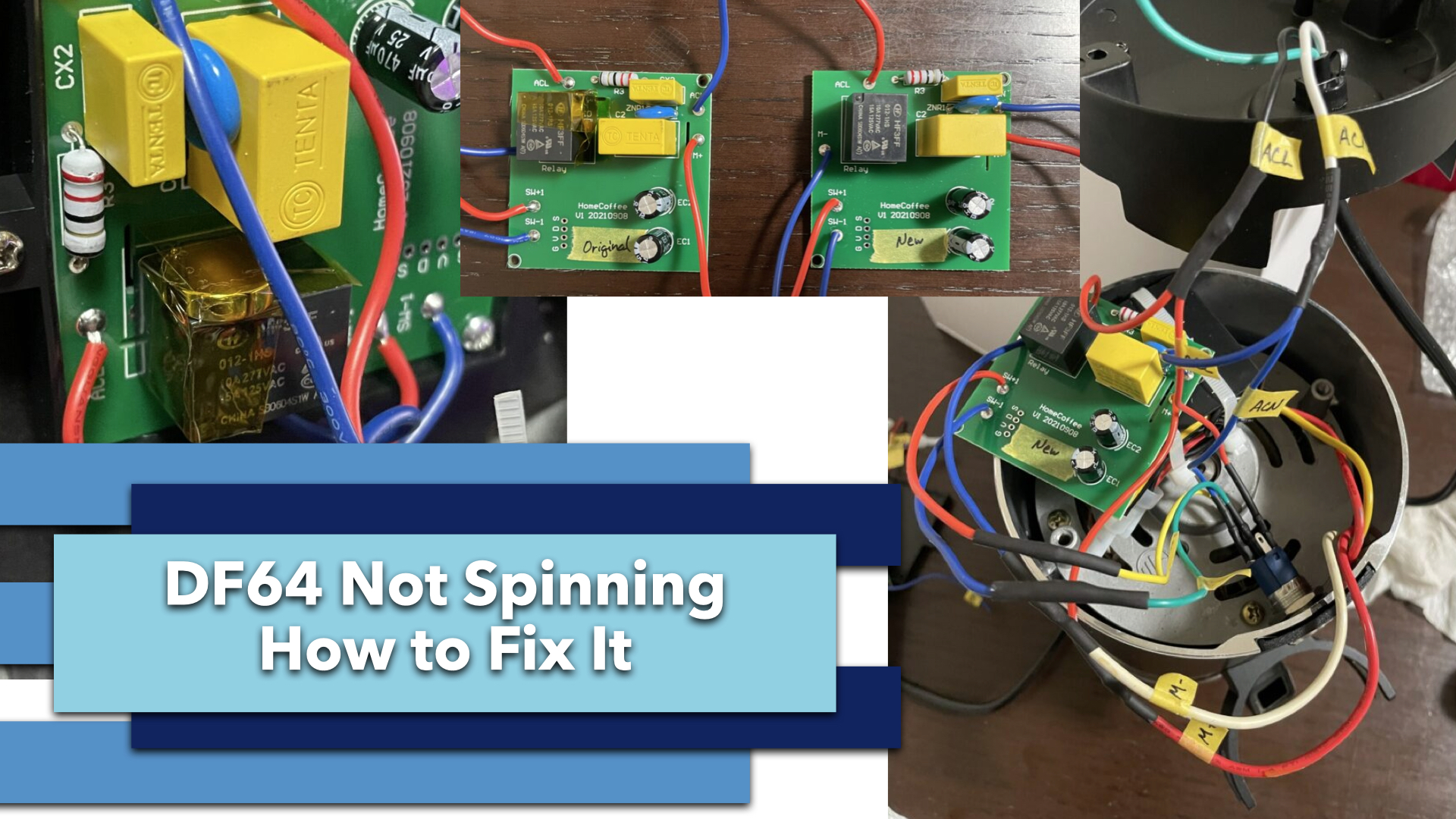

コメント